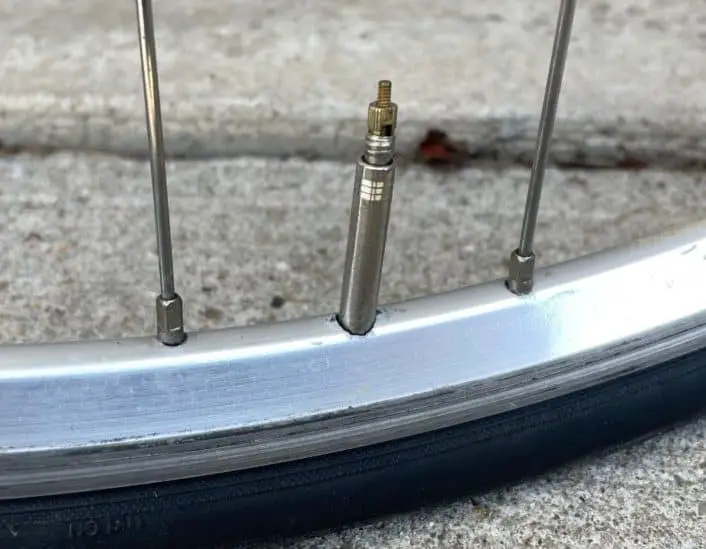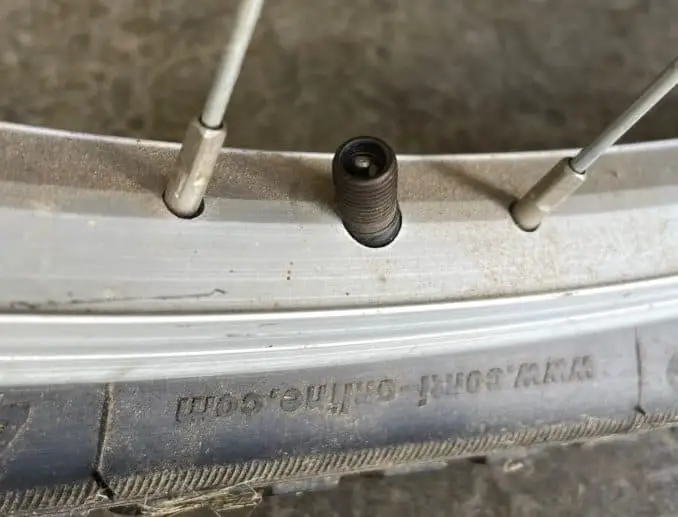When you come across a flat bike tire, it’s nice to know there’s an easy fix with a bike pump on hand. But what do you do if your bike pump isn’t working!?
First of all, don’t worry. Most bike pump issues have a simple solution, and in this guide I’ll explain how to solve 6 of the most common bike pump problems. Here’s what we’ll cover:
1. Bike Pump Not Attaching/Locking
A common problem you may encounter is your bike pump not attaching properly. You may have put the nozzle on the valve and find that it falls off as soon as you start pumping.
Here’s what may be happening:
Inside the nozzle there is a bolt system in place to ensure that the nozzle gets locked on to the valve. When the lever is pulled to lock the bike pump nozzle to the valve on your tire, the bolt turns, locking everything into place.
If the connection between your bike pump and your tire valve is not flush, or if the bolt has been compromised, the pump will not latch on properly, causing difficulties with inflation.
This can be a problem for both major types of bike valves; Schrader and Presta. If you’re not sure which valve you have…
Here’s a photo of a Presta valve:

And here’s a photo of a Schrader valve:

Solution
The lever on your bike pump nozzle ensures that it locks to the valve on your tire. The very first step is understanding when and how to use the lever on your pump.
Start with the lever “unlocked”, which often means that the lever will be pointed down towards the ground. Then, mount the nozzle onto the tire’s valve. Once it’s secure, flip the lever so that it is parallel with the ground. This should lock the nozzle into place.
If you have a Presta valve, there will be a small tip that can be unscrewed. You will need to loosen this tip before putting the bike pump nozzle on; check to see if you’ve done this step.
To confirm, when the tip is loosened and you press on the valve, if you press on it lightly, air should come out.
Refer to this video for a live demonstration of connecting a bike pump to a Presta valve:
Refer to this video for a demonstration of connecting a bike pump to a Schrader valve:
If the nozzle is still not attaching, there may be an issue with your bike pump nozzle.
Inside the pump’s nozzle is a small bolt, this turns and locks everything into place once the lever is engaged. If the bolt in your nozzle is compromised, you may need to get a replacement.
Some pumps and valves have indicative vertical lines on them; to ensure that the bolt has locked into place, be sure to line up the vertical line of the tire valve with the vertical line on the pump nozzle.
Once you’ve made sure that your valve is ready, carefully mount the bike pump. Try pulling the lever on the nozzle up again, and feel for the locking to take place. This should solve the problem.
2. Bike Pump Not Pumping Air (No Resistance)
A bike pump that isn’t pumping air into your tire can be frustrating. You may find that you are pumping repeatedly and don’t get any visible sign that air is going into your tire. Or, you will hear the air hissing out as soon as you press down on the pump.
This problem is similar to the previous issue, but it’s a little bit different, because the issue here is likely not with the locking mechanism, but with the connection. In other words, you probably just need to get a better connection between the pump and the tire.
Solution
You may simply need to remove the pump and try putting it on the valve again to ensure that the valve gets fully connected.
Personally, this is the most common problem I’ve had with using bike pumps. And I find that it can be helpful to use both hands to ensure that you are seating the pump firmly.
If you continue to have problems, try pressing a little harder before you lock the pump nozzle in place. Then, also check to make sure you are keeping both the nozzle and the valve straight. If the pump gets connected at an angle, this can easily cause problems with inflating your tires.
If you are thinking of using a ball pump instead, read our article on whether or not you can use a ball pump on a bike tire first.
3. Bike Pump Not Showing Pressure (Gauge Issues)
The gauge on your bike pump ensures that your tires are properly inflated. If you know the PSI of your tire, and it matches the gauge, you’re good to go.
However, problems can arise with the gauge that’s built into your bike pump. If you find that your gauge isn’t showing a pressure reading, you may have a leak somewhere between your bike pump hose and your tire valve.
The gauge will only show a reading, or a proper reading, if the pressure is allowed to build and maintain in the hose.
A leak will compromise this process.
Solution
To fix the issue, first check to make sure there aren’t any punctures in your bike pump hose. If there are no visible punctures, you may want to try submerging the bike pump hose in water. If you see bubbles, you know you have a leak.
Also, make sure that you have placed the nozzle on your tire valve correctly. Sometimes this is the first and easiest fix to most bike pump issues.
If you conclude that there aren’t any leaks compromising your bike pump hose, and you are applying the nozzle correctly to the tire valve, you may need to replace the gauge.
The gauge on a bike pump can be easily removed and replaced with a new one. The gauge is secured to the bike pump via a thread lock mechanism, and after time this may simply have worn out.
Here is a simple instructional video on how to replace a gauge on a floor pump:
4. Bike Pump Not Going Down (Too Hard to Move)
If you’re trying to push the handle on your bicycle pump and it’s not going down, here’s what’s going on:
You may have forgotten to open the top of your Presta valve. If you have not loosened the top piece, no air will be allowed to flow, thus pressurizing the bike pump tube and making it difficult to press down.
Alternatively, the nozzle may not be making a flush connection with your tire valve.
Both of these problems will prevent air from flowing out of your pump, which means that each time you try to press the pump handle, it’s like you’re fighting against a bunch of pressurized air, and you won’t be able to move the pump down (at least not much).
Solution
Start by loosening the tip of the valve (in the case of Presta valves). Make sure that you have a proper connection between the bike pump nozzle and your valve. The pin in the valve needs to be accurately pressed down to allow air to flow in.
If that doesn’t fix it for you, then check the tire valve. Often it is the valve that is stuck or clogged, not the pump. Try moving the valve gently back and forth or pressing down lightly on the valve. If you hear a spurt of air coming out, then that’s a good sign that it is working properly.
5. Bike Pump Won’t Stay on Valve
If you place your pump nozzle onto the valve on your tire and it comes right off, that can be frustrating. Here’s what may be going on:
Either the bike pump nozzle lever is not in the correct position, or your pump nozzle may be worn out.
Solution
Place the bike pump nozzle over your tire valve. In this step, you’ll want the lever on the pump nozzle to be in a downward position. Once you’ve placed the nozzle over the valve, flip the lever, bringing it parallel to the ground. This will ensure that the nozzle is locked onto the valve.
If your pump still won’t latch on, here are some other common solutions…
Take a close look at your pump nozzle. Some nozzles have rings on the head of them, in place to adjust tension. If the ring is tightened properly, there will be enough tension to stay attached to the valve.
Make sure the ring is properly tightened.
Additionally, there is a rubber piece inside the head of the nozzle, after time it can wear out causing it to ineffectively grip the valve on your tire. If you’re able to, unscrew the head of the nozzle and check the rubber piece. Replacing this piece may fix the problem.
6. Bike Pump Won’t Come off Without Losing Air
We’ve all been there; we just finished inflating a bike tire to perfection and while trying to maneuver the nozzle off, we hear air leaking out.
Losing a little bit of air when removing the bike pump nozzle from your tire valve is normal. If it doesn’t cause you to have to re-inflate your tire, it’s fine.
The issue arises when a significant amount of air is lost while you’re removing the nozzle from the valve. If you find that you have to re-inflate your tire, that is a significant loss of air. This can be frustrating, as you just pumped up your tire!
Solution
Sometimes, when you hear air coming out while removing the bike pump, it’s actually coming from the pump itself and not your tire. Check your tires after you get the nozzle off to confirm that they are either still inflated sufficiently, or that you need to re-pump.
Quick, careful movements can help you decrease the amount of air lost while taking off the bike pump nozzle. Remember, while pumping air in, you’ll want the lever on the nozzle to be parallel to the ground.
Once you have inflated your tire sufficiently, return the lever to the original “unlocked” position.
Here is where quick action is best. Pull straight up to detach the nozzle from the valve. You may need to rock the nozzle slightly back and forth to remove it if it’s not coming off easily.
In conclusion, most bike pump issues you’ll come across will have a simple fix. In the event that you aren’t able to troubleshoot on your own, you may consider buying a new pump; just like anything else, they will need replacing from time to time.
I hope you found this article informative, happy riding!
